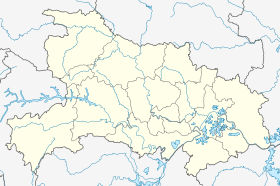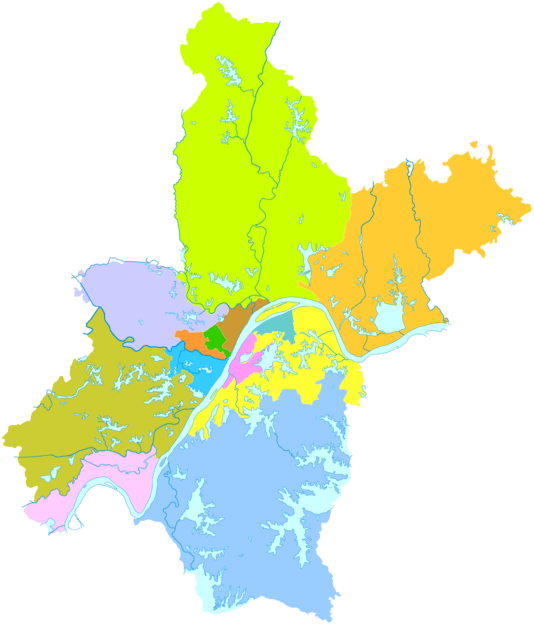Wuchang District
| Wuchang 武昌区 | ||||||||||||||||||||||||||||||||||||
|---|---|---|---|---|---|---|---|---|---|---|---|---|---|---|---|---|---|---|---|---|---|---|---|---|---|---|---|---|---|---|---|---|---|---|---|---|
| District | ||||||||||||||||||||||||||||||||||||
|
| ||||||||||||||||||||||||||||||||||||
 Wuchang Location in Hubei | ||||||||||||||||||||||||||||||||||||
| Coordinates: 30°33′43″N 114°20′25″E / 30.5619°N 114.3404°ECoordinates: 30°33′43″N 114°20′25″E / 30.5619°N 114.3404°E[1] | ||||||||||||||||||||||||||||||||||||
| Country | People's Republic of China | |||||||||||||||||||||||||||||||||||
| Province | Hubei | |||||||||||||||||||||||||||||||||||
| Sub-provincial city | Wuhan | |||||||||||||||||||||||||||||||||||
| Area[2] | ||||||||||||||||||||||||||||||||||||
| • Total | 87.42 km2 (33.75 sq mi) | |||||||||||||||||||||||||||||||||||
| Population (2010)[3] | ||||||||||||||||||||||||||||||||||||
| • Total | 1,199,127 | |||||||||||||||||||||||||||||||||||
| • Density | 13,717/km2 (35,530/sq mi) | |||||||||||||||||||||||||||||||||||
| Time zone | China Standard (UTC+8) | |||||||||||||||||||||||||||||||||||
| Wuhan district map |
| |||||||||||||||||||||||||||||||||||
| Website |
wuchang | |||||||||||||||||||||||||||||||||||
Wuchang District (simplified Chinese: 武昌区; traditional Chinese: 武昌區; pinyin: Wǔchāng qū) forms part of the urban core of and is one of 13 districts of Wuhan, the capital of Hubei province, People's Republic of China. It was one of three cities that merged into modern-day Wuhan, and stood on the right (southeastern) bank of the Yangtze River, opposite the mouth of the Han River. The two other twin cities, Hanyang and Hankou, were on the left (northwestern) bank, separated from each other by the Han.
The Wuchang fish (Megalobrama amblycephala; 武昌鱼; 武昌魚; Wǔchāng yú) is named after the town.
The name "Wuchang" remains in common use for the part of urban Wuhan south of the Yangtze River. Administratively, however, it is split between several districts of the City of Wuhan. The historic center of Wuchang lies within the modern Wuchang District, which has an area of 82.4 square kilometres (31.8 sq mi) and a population of 1,003,400.[4] Other parts of what's colloquially known as Wuchang are within Hongshan District (south and south-east) and Qingshan District (north-east). Presently, on the right bank of the Yangtze, it borders the districts of Qingshan (for a very small section) to the northeast and Hongshan to the east and south; on the opposite bank it borders Jiang'an, Jianghan and Hanyang.
History

The old Wuchang county
In 221, warlord Sun Quan moved the capital of Eastern Wu from Gong'an county, Jingzhou (northwest of present-day Gong'an county, Hubei) to È county (in present-day Ezhou City), and renamed È to Wuchang (literally prospering from military, regarding its logistics role of the military bases established before the Battle of Red Cliffs). Later in the year Cao Pi proclaimed himself the emperor of Cao Wei. Sun Quan declared independence in the following year, and started to build forts and palaces in Wuchang. Sun Quan proclaimed himself the emperor of Eastern Wu in 229, and moved the capital to Jianye. Sun Hao, the emperor of Eastern Wu between 264 and 280, moved the capital back to Wuchang in 265. In 589, the Wuchang commandery was abolished and the Wuchang county was transferred to a new commandery named Ezhou (headquartered in present-day Wuchang District), and remained in the administration since then.
The present day Wuchang town

The Wuchang commandery was set up when È was renamed to Wuchang, and included six counties. In 223 the commandery was renamed to Jiangxia, and the capital of the commandery moved to Xiakou (in present-day Wuchang town). The name of the town was switched back and forth between Wuchang and Jiangxia several times in the following centuries. After 1301, the Wuchang prefecture, headquartered in the town, became the capital of Hubei province.
At the end of the Qing Empire, the Wuchang Prefecture was the capital of the combined provinces of Hubei and Hunan, called the 'two Hu' or Huguang Viceroyalty. It was the seat of the provincial government of Huguang, at the head of which was a viceroy of Huguang. Next to Nanjing and Guangzhou, it was one of the most important vice-royalties in the empire.
It possessed an arsenal and a mint. The provincial government established ironworks for the manufacture of rails and other railway material. As the works did not pay under official management, they were transferred to the director-general of railways. Wuchang was not open to foreign trade and residence, but a considerable number of missionaries, both Roman Catholic and Protestant, lived within the walls. The native population was estimated at 800,000 around 1911, including cities on both banks. At that time, Wuchang was an important junction on the trunk railway from Beijing to Guangzhou; and was on the route of the Sichuan railway.
In Wuchang on October 10, 1911, a revolt broke out against the Qing Dynasty. This event, now called the Wuchang Uprising and celebrated as Double Ten Day, was the catalyst that started the Xinhai Revolution, which led to the development of the Republic of China.
In 1912, the Wuchang prefecture was abolished and a new Wuchang county (just next to the Wuchang county in the EZhou city) was created. In 1926 the Wuchang town was promoted to a city, and merged with Hankou and Hanyang to form a new city named Wuhan.
After 1949, the more urban part of the Wuchang County was absorbed into the new Wuhan City and was administratively partitioned into Wuchang, Qingshan and Hongshan districts, while the remaining, mostly rural, southern part retained the name of Wuchang County. In 1995, Wuchang County became Jiangxia District of Wuhan.
References
- ↑ Google (2014-07-02). "Wuchang" (Map). Google Maps. Google. Retrieved 2014-07-02.
- ↑ "Wuhan Statistical Yearbook 2010" (PDF). Wuhan Statistics Bureau. p. 15. Retrieved 2011-07-30.
- ↑ "武汉市2010年第六次全国人口普查主要数据公报". Wuhan Statistics Bureau. 2011-05-11. Archived from the original on 2011-10-25. Retrieved 2011-06-11.
- ↑ "Profile of Wuchang District" (in Chinese). official website of Wuchang District Government. Archived from the original on 2008-03-24. Retrieved 2008-04-19.
External links
| Wikimedia Commons has media related to Wuchang District. |

